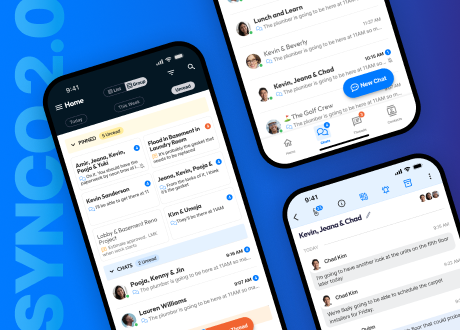In today’s property management landscape, “centralization” is the hottest buzzword, promising more efficiency through technology and a streamlined way of operating properties at scale. While property management centralization can improve processes and reduce costs, it also presents a communication catch-22 that can impact resident satisfaction and company morale.
In this post, let’s dive into why we still face communication challenges in the industry, even with two decades of technological advancements. And more importantly, let’s discuss what we, as property management leaders, can do about it.
When Functions Are Streamlined – But Communication Isn’t
When we centralize functions in property management, like leasing, accounting, or maintenance operations, we tend to focus on the mechanics of that function, i.e., what needs to happen for the residents, the prospects, the office, and the recordkeeping.
But sometimes, we overlook the importance of considering who needs to communicate with whom to get the job done. We streamline the function but need to remember the conversations that need to occur around it.
Team members still need to communicate in one place to track ongoing maintenance issues like flooding or repair projects, coordinate around resident complaints, and provide weekly updates to management.
When your team isn’t able to have the quick back-and-forth conversations to ensure these tasks are complete, it leaves them feeling even more disconnected.
The Great Disconnect: Corporate vs. On-Site Operations
When we centralize, the idea is to bring our teams together to work more efficiently. But here’s the thing: property management teams still find themselves going through thousands of emails, texts, and WhatsApp messages just to find information. They end up spending more time searching for information than actually solving problems.
That’s the catch-22 of centralization: by implementing tech platforms to streamline certain functions, we inadvertently create communication silos where vital information gets trapped in various systems, limiting access for certain teams.
For instance, you need to escalate an ongoing roof issue at a property to your regional facilities team for a more extensive repair project. How do you access the photos related to that issue, which may go back months or even years? Are they stuck in the maintenance work order system or old email chains, making them hard to find?
While technology simplifies complex processes, it can also complicate simple tasks like letting the leasing team know a unit is ready for move-in or finding a property’s contact list. With multiple platforms for communication and storage, it’s easy to feel overwhelmed. These challenges can frustrate employees who want to do their jobs well, leading to high turnover rates.
The Culprits in Communication Lag
So, how can you avoid these hiccups when adopting new platforms that help with centralization? First, we must look at the gap between the ideal centralized operation and how we function daily.
Despite operational efficiency being the goal for property management teams, many of us still rely on email and texting for day-to-day operations. So, while centralization technology and practices have made their way into various aspects of the property management workflow, the basics, like communicating with coworkers, are stuck in the year 2000.
Now that we’ve pinpointed the challenges caused by the lack of innovation in communication, let’s dive into the specific breakdowns that can slow down response times and make property management processes even more frustrating.
Process Breakdowns Can Slow Down Response Times
Communication gaps become most apparent when our automated processes fail to go as planned. Sure, centralized rent payment has eliminated the need for on-site staff to collect checks or worry about payments. But even with our well-honed processes, we’re still human – and so are our residents.
These communication gaps rear their head when the automated process doesn’t go as planned. Because we’re not machines, we can’t be expected to behave the same way every time.
Sometimes, there is simply no substitute for good old-fashioned human interaction – for example, when a resident has questions about their upcoming renewal and needs help. The ideal scenario: a quick, internal conversation is created that loops in accounting, the on-site team, and leasing – and then someone gets back to the resident quickly about their question. If this is done over disjointed email chains or texts that no one sees, somewhere along the line, things get dropped.
We need an extra layer of real-time communication that ensures everyone gets their questions answered promptly – and the answer isn’t emailing and texting.
Email and Text Overload Still Persist
Property management teams have experimented with using tech platforms to tackle efficiency problems. But here’s the thing: many of these platforms just flood our inboxes with emails.
We’ve all been bombarded with those email alerts about new inspection tasks or when a new prospect is added to the CRM. Managing all those emails, filing or deleting them, and then trying to find them later is the opposite of efficiency.
And here’s another issue: not everyone can access or get trained on these department-specific platforms. So, how do we share that information when a process moves from one department to another?
Take the make-ready process for a unit, for example. The prospect’s lease gets signed in the CRM, but how do we let the on-site team know so they can add it to their make-ready process?
Ultimately, text messaging becomes the last resort for communication more often than we’d like to admit.
Email and texting aren’t designed for the sophisticated processes that property management teams are undertaking. Relying on these platforms for communication creates even more siloes, negating the progress we’ve made toward centralization.
“We run a highly centralized, team-member-lite operation. Finding ways to make our communication more efficient and being able to sift through messages & information for different properties on different topics was an operational necessity for us.”
Mario Gaztambide, Senior Managing Director, Residential Properties, LeFrak Organization
How Property Management Companies Can Instantly Improve Communication
When it comes to achieving operational excellence, one of the key factors is empowering your team to communicate across departments quickly in one place. This saves time by eliminating duplicate efforts, those dreaded “where are we on this?” emails and texts, and allows your team to focus on running better properties instead of figuring out how to get in touch with each other.
Synco was built to enable the modern property management team to communicate better. Unlike traditional email or disjointed text chains, Synco is purpose-built for property management teams. The Synco platform integrates with your property management tech stack, seamlessly captures and shares photos, facilitates instant messaging, and keeps your boots-on-the-ground team effortlessly connected to the corporate office.
As we embrace the centralized model, let’s remember the crucial role of keeping our communication connected and optimized.
Ready to test-drive Synco instantly? Click here!



